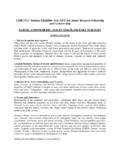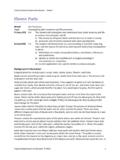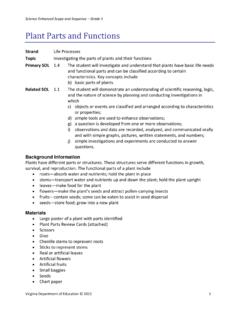Transcription of LIFE SCIENCES - Human Resource Development …
1 life SCIENCES This Test Booklet will contain 145 (20 part `A +50 part `B+75 part C ) Multiple Choice Questions (MCQs). Candidates will be required to answer 15 in part A , 35 in part B and 25 questions in part C respectively (No. of questions to attempt may vary from exam to exam). In case any candidate answers more than 15, 35 and 25 questions in part A, B and C respectively only first 15, 35 and 25 questions in Parts A, B and C respectively will be evaluated. Questions in Parts `A and B carry two marks each and part `C questions carry four marks each. There will be negative marking @25% for each wrong answer.
2 Below each question, four alternatives or responses are given. Only one of these alternatives is the CORRECT answer to the question. MODEL QUESTION PAPER part A May be viewed under heading General Science part B 21. Which of the following bonds will be most difficult to break? 1. C O 2. C C 3. C N 4. C S 22. A solution of 1% (w/v) starch at pH is digested by 15 g of -amylase (mol wt 152,000). The rate of maltose (mol wt = 342) had a maximal initial velocity of mg formed per min. The turnover number is 1. 105 min 1. 2. 25 105 min 1. 3. 105 min 1. 4. 104 min 1.
3 23. The conformation of a nucleotide in DNA is affected by rotation about how many bonds? 1. 4 2. 6 3. 7 4. 3 24. Which of the following proteins acts as an energy transducer? 1. G-protein. 2. Bacteriorhodopsin. 3. Hemoglobin. 4. Heat shock protein. 25. Which of the following predicted property of lipid bilayers would result if the phospholipids had only one hydrocarbon chain instead of two? 1. The bilayers formed would be much less fluid. 2. The diameter of the head group would be much larger than the acyl chain and would tend to form micelles rather than bilayers. 3. the bilayers formed would be much more fluid.
4 4. the bilayers would be more permeable to small water-soluble molecules. 26. Which pump is responsible for initiating muscle contraction through depolarization of muscle cell membrane? 1. Na+ pump. 2. K+ pump. 3. Ca2+ pump. 4. Mg2+ pump. 27. Which of the following statements is not true for transposable element system? 1. It consists of both autonomous and non-autonomous elements. 2. Dissociation elements are autonomous in nature. 3. Transposase is transcribed by the central region of autonomous elements. 4. Certain repeats in the genome remain fixed even after the element transposes out. 28. A set of virulence genes (vir genes), located in the Agrobacterium Ti-plasmid, is activated by 1.
5 Octopine. 2. nopaline. 3. acetosyringone. 4. auxin. 29. When two mutants having the same phenotype were crossed, the progeny obtained showed a wild-type phenotype. Thus the mutations are 1. non-allelic. 2. allelic. 3. segregating from each other. 4. independently assorting. 30. A conjugation experiment is carried out between F+ his+ leu+ thr+ pro+ bacteria and F his leu thr- pro- bacteria for a period of 25 minutes. At this time the mating is stopped, and the genotypes of the recipient F bacteria are determined. The results are shown below: Genotype Number of colonies his+ 0 leu+ 13 thr+ 26 pro+ 6 What is the probable order of these genes on the bacterial chromosome?
6 1. thr, leu, pro, his 2. pro,leu, thr and the position of his cannot be determined. 3. thr, leu, pro, and the position of his cannot be determined. 4. his, pro, leu, thr 31. Two varieties of maize averaging 48 and 72 inches in height, respectively, are crossed. The F1 progeny is quite uniform averaging 60 inches in height. Of the 500 F2 plants, the shortest 2 are 48 inches and the tallest 2 are 72 inches. What is the probable number of polygenes involved in this trait? 1. Four. 2. Eight. 3. Sixteen. 4. Thirty two. 32. Repair of double strand breaks made during meiosis in the yeast Saccharomyces cerevisiae 1.
7 Occurs mostly by non-homologous end joining. 2. occurs mostly using the sister chromatid as a template. 3. occurs mostly using the homologous chromosome as a template. 4. is associated with a high frequency of mutations. 33. Which of the following signaling molecules enters the cell to initiate its action? 1. Transferrin 2. Insulin 3. Glucagon 4. Thyroxine 34. The mode of action of the anticancer drug methotrexate is through its strong competitive inhibition on 1. dihydrofolate reductase. 2. thymidine synthase. 3. thymidine kinase. 4. adenylate cyclase. 35. Which class of immunoglobulins will increase in case of a chronic infection?
8 1. IgA 2. IgG 3. IgM 4. IgE 36. When prospective neuroectoderm from an early amphibian gastrula is transplanted in the prospective epidermal region of a recipient (early gastrula) embryo, the donor tissue will give rise to 1. neural tube. 2. epidermis. 3. neural tube and notochord. 4. neural tube and epidermis. 37. Amphibian oocytes remain for years in the diplotene stage of meiotic prophase. Resumption of meiosis is initiated by 1. gonodatropic hormone. 2. growth hormone. 3. oestrogen. 4. progesterone. 38. A group of six cells called 'equivalence group cells' divide to form the vulval structure in Caenorhabditis elegans.
9 They are called so because 1. they have similar fates during Development of vulva. 2. all the six cells are competent to form vulva and can replace each other under various experimental conditions. 3. they are all under the influence of the anchor cell, signals from which initiate vulval Development . 4. they interact with each other to form the vulval structure. 39. Due to the presence of cellulose in the cell wall of plants, leaf shape is determined in the leaf primorida by 1. rates of cell division. 2. planes of cell division. 3. cell migration. 4. cell-cell interactions. 40. DCMU inhibits electron transport in chloroplast by preventing the reduction of 1.
10 P 680. 2. QA. 3. PQ. 4. QB. 41. In higher plant leaves, the reduction of nitrate to ammonium takes place by the combined action of nitrate reductase localized in cytosol and nitrite reductase localized in 1. peroxisomes. 2. mitochondria. 3. chloroplasts. 4. cytosol. 42. In higher plants, the red/far-red sensory photoreceptor, phytochrome, is a light-regulated kinase. Which of the following classes of kinases does it represent? 1. Two-component sensor regulator (histidine kinase). 2. Two-component sensor regulator (serine/threonine kinase). 3. Leucine rich repeat (LRR) receptor kinase. 4. Calcium-dependent protein kinase.
















